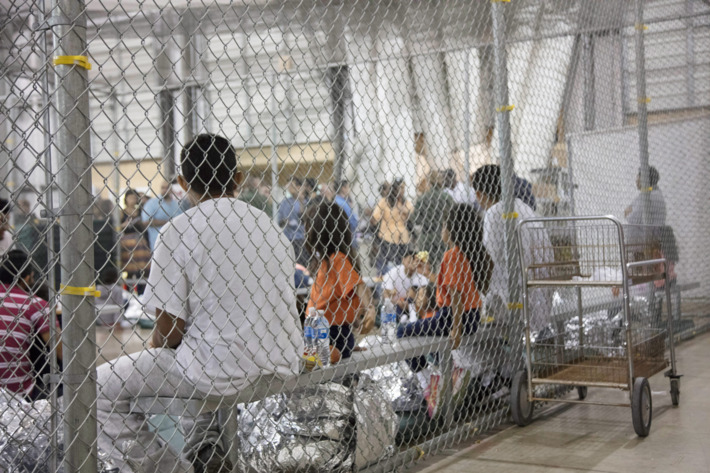Cyryl Ryzak
February 4, 2019
“The Left case Against Open Borders” is wrong on the immigrant rights movement. It is wrong in its supposed materialist analysis. It is wrong on how we should view the legacy of Old Left
“The Left Case against Open Borders” by Angela Nagle is an essay with a misleading title. The article doesn’t argue against “open borders”. Nagle argues against the cause of immigrant rights and for a more repressive immigration policy, while attacking the supposedly “upper middle class”, “identitarian” present day Left as neoliberals who facilitate the super exploitation of immigrant workers
Her argument is not entirely original. In a New York Times opinion piece, John Judis admonished liberals and leftists for belittling “national identity”. Like Nagle, he thinks we are too soft on immigrants.
Behind Nagle and Judis’ anti-globalization position is an economistic argument. When foreigners migrate to another country, they increase competition with native born workers on the labor market, lowering conditions for everyone. Globalization has created a situation where, fleeing poverty at home, migrants are flooding the more advanced economies. The result is a boon for business, the secret benefactor, maybe even the puppeteer, of illegal immigration.
Wrapping herself in the red flag, Nagle argues that ”the Left should take its bearings from its own long traditions.” Didn’t Cesar Chavez’s UFW oppose illegal immigration at one point? Using an out of context quotation from Marx, Nagle attributes to him the view that competition between native born and immigrant workers is the source of racial tensions.

In the minds of “Left” anti-immigrant polemicists, since competition drives down wages, the Left should accept the need for greater restrictions on immigration and at the same time tackle “its root causes”-“the financialization of the world economy. To prevent emigration, every country should adopt “state-led development” leading ultimately to a robust social democratic welfare state
Nagle conjures up a parody of “internationalism” to save her from accusations of right-wing pandering. According to her scheme, migrants will have to endure greater repression until a basically revolutionary, worldwide political shift cuts across regional particularities in all of Asia, Africa, and Latin America putting in power strong Lefts building social democracy in every poor country.
“The Left case Against Open Borders” is wrong on the immigrant rights movement. It is wrong in its supposed materialist analysis. It is wrong on how we should view the legacy of Old Left. Nagle’s views are a mockery of socialism, removed from the struggles raging in the present.
Organize Immigrant Workers Rather than Excluding Them
Immigrants currently staff many of the key sectors of the American economy, including agriculture, meat-processing, and construction. It’s impossible to effectively organize those industries without also organizing immigrant workers.
In the past many unions advocated using repression against migrant workers as a defense against competition from immigrant workers. This was always, however, counter-productive. The great waves of unionization in the 19th and 20th centuries required the combination of vast multitudes of immigrants from a wide array of origins. The labor movement was most effective when it organized among immigrants rather than against them. Since 2000, American trade unionists have recognized that the restrictiveness of immigration policy—not its looseness– allows for migrants to be super-exploited; undocumented workers have no legal recourse to violations of labor law. Employers use the threat of deportation to prevent the undocumented from organizing.

A recent case in Alabama shows the harmful effects of restrictive immigration policies. HB 56 required employers to report the immigration status of their workers through the E-Verify system. It was a disaster for Alabama’s poultry workers. Many undocumented workers fled the chicken processing plants. Those undocumented who stayed were intimidated by employers to perform even more dangerous work lest they be reported.
Very few new workers were hired. Instead, as the number of workers on the job dropped, line speeds increased. As the Southern Poverty Law Center reports, employers “threatened mass firings if workers cannot keep up with the faster pace…”. In plants already notorious for their lax safety standards, speed-up meant increasing the risk of serious hand injuries.
Nagle supports a national E-verify mandate, which the AFL-CIO opposes:
“Absent broader immigration reform, a national E-Verify mandate will push millions of working people deeper into the shadow economy, further undermining our freedom to join together and fight to raise wages for all.”
Nagle’s favorite rhetorical trick is to oppose an “Old Left” sensibility to an adolescent, moralizing “identity politics”. But those she attacks as “upper middle class” “identitarians” are community and workplace organizers performing extremely heavy political labor in unfavorable circumstances. And by arguing that marginalized minorities are completely irrelevant to socialism, and, moreover, harmful to it, she reinforces prejudices about Marxism’s supposed class reductionism.
Social Solidarity in Proletarian Struggle
It is insightful to compare Nagle’s concept of “materialism” with that of Karl Kautsky, “Pope” of Marxism before the First World War, often characterized as an arch-economic determinist and class reductionist. In his explanatory booklet for the German Social Democratic Party’s program, The Class Struggle, he, contra Nagle, seemed to think the working class had a great capacity for solidarity, “The proletariat, as the lowest of the exploited strata, cannot free itself from exploitation and oppression without putting an end to all exploitation and oppression. It is, therefore, their sworn enemy, no matter in what form they may appear; it is the champion of all the exploited and oppressed.”
Socialists claim that workers have an interest in production being run according to social, co-operative, and humanitarian criteria, rather than for competitive imperatives, enrichment, or the destruction of war and environmental degradation. Production, however, cannot be run for the common good if social relations in production are egotistical and based on the unquestionable superiority of a master. Production must be transformed by the very organization of the proletariat-in-struggle, a collective united by common disadvantage. As Georg Lukacs put it in one of his essays written during the 1919 Hungarian Soviet Republic, “The very solidarity propagated as an unattainable social ideal by the greatest bourgeois thinkers is in fact a living presence in the class interests of the proletariat.”
Socialism is collectivism in a pure form. It is not an egoistic collectivism based upon a prefixed racial or national category, in endless struggle with other collective egos. Socialism is the sincere substance of a collective bond. This collectivism, like capital, its enemy, cannot acknowledge any arbitrary limits. The ascendant bourgeoisie of the early 19th century in Marx’s famous words “drowned the most heavenly ecstasies of religious fervor, of chivalrous enthusiasm, of philistine sentimentalism, in the icy water of egotistical calculation.” Instead of “the icy water of egotistical calculation”, a socialist working class must wash society with solidarity.
The social principle around which socialism wishes to see society organized is born in production, but precisely because our existence is shaped by the economy, it is a powerful force for shaping other non-economic spheres. The “primacy” of class derives from socialism’s goal: the transformation of society as a totality.
Materialism is not an excuse to belittle “non-class” forms of oppression, but, on the contrary, the key to understanding how to unite seemingly unconnected fights against various injustices. This unity begins within the working class itself, which across its ranks includes people suffering from every inequity. It is senseless for workers fighting together in a common struggle to ignore the plights faced by their fellow workers, even when they are not shared by all.
Some will object that not only are these wild hopes, they also belittle the efforts of anti-racist, feminist, and LGBT activists, privileging class solidarity over the solidarities formed in struggles, for example, against police brutality and for reproductive rights.
This objection is a serious one. The “primacy” of class always has the potential to degenerate into something akin to the position of Sarah Wagenknecht of Germany’s Die Linke: eliminate neoliberalism first, help refugees, if ever, later.
Socialists cannot ask social movement activists to put everything on hold until we achieve some new “New Deal” government policy. It must acknowledge their labor, their collective commitment, and the power of their solidarity. It is the lowest form of “Marxist” analysis to say that churches housing undocumented migrants are superficial, while run of the mill business unionism is something radical.
Nonetheless, socialism has to be straightforward. The social movements are like the Polish insurrectionists of 1863 in support of whom the Workingman’s International was founded, or Castro’s guerillas in the Sierra Maestra. While Cuba’s July 26 Movement would win with the crucial support of the Cuban working class, culminating in the general strike of January 1959, the Polish uprising would fall on Tsarist bayonets, demonstrating the need for an international working-class movement that could effectively challenge Reaction worldwide.

Guerilla wars fought by small bands are heroic endeavors and sometimes they can defeat a vastly superior force. But it really helps to have an army. The working class is that army.
The social movement Left is not “neoliberal” or an ally of “the forces of cognitive capitalism, especially financialization” as Nancy Fraser once argued. It is, however, a victim of capitalism’s own compartmentalization of “morality” as something outside of bread and butter concerns. When Adam Smith argued that human nature is divided between self-interest and sympathy, he was describing the nature of bourgeois man. The efforts of social movement activists to awaken society are not entirely in vain, but greatly weakened under capitalism, where, alongside their moral commitments, people inhabit a realm of exploitation, ruthlessness, and indifference. No matter how powerful the solidarity of social movements, the rot of bourgeois society can always undermine it. They need a force that can fight the rot on its own terrain.
Socialism gives social movements a powerful motive force to charge their efforts. Even short of social transformation, a socialist working class reworks the fabric of daily life. “Theory” Mark wrote, “becomes a material force as soon as it has gripped the masses”. Socialist ideals once had a living, breathing existence in Communist factory cells, welfare provision through “ghetto socialism”, and clandestine meetings at kitchen tables during anti-fascist struggles. They were alive in Red Clydeside in Glasgow, in Red Wedding in Berlin, in the Red Basin of Upper Silesia. Socialism became an organic part of these and other working-class communities
Class struggle and social movements complement one another. The solidarity of the working class is qualitatively strengthened by participating in social movements, while social movements gain a completeness and foundation when based in the working class. Rosa Luxemburg expressed this relation when she wrote, “To the credit of mankind, history has universally established that even the most inhumane material oppression is not able to provoke such wrathful, fanatical rebellion and rage as the suppression of intellectual life in general, or as religious or national oppression. But only classes which are revolutionary by virtue of their material social situation are capable of heroic revolt and martyrdom in defense of these intellectual riches.”
The goal of a socialist working class from the point of the view of the present seems like an unattainable goal. It would be foolish to deny that building such a class movement requires a tremendous effort. The history of the American labor movement’s relationship to white supremacy is one of a tortuous struggle with deeply settled social prejudices within the leadership and membership of unions. But the ultimate lesson of this history is that black workers, organizers, and socialists were capable of forcing the movement to take its principles seriously. By the time of the civil rights movement, unions, at least in rhetoric, gave their support to the struggle against Jim Crow. And when they failed to live up to their rhetoric, they were challenged by powerful movements from below, like the League of Revolutionary Black Workers.
Socialist Ideals Are Alive in the Immigrant Workers’ Movement
Given the scale of the task, when a movement of workers emerges which points in the direction of what socialists wish to achieve, they must celebrate and give aid to it. If there’s any place today where the ideals of the socialist movements of the past still have life it is the immigrant struggle. Far from being opposed to the ideals of the Old Left, movements of immigrant workers, and efforts of solidarity with them, are a testament to socialism’s basic hope.
Nagle’s imagined immigrant rights movement is completely at odds with the really existing one. What other struggle has exemplified what going beyond mere “identity politics” can achieve? By its nature, the immigrant movement combines labor organizing and anti-racism in a form where they cannot be separated. This fight against exploitation must also be a fight against state repression against minorities. Community organizing complements that of the workplace.
Immigrant workers have revitalized the labor movement, waking it up from its bureaucratic slumber with a fresh militancy. Los Angeles was rocked by grassroots struggles rooted in the Latino, heavily immigrant, working class. The famous “Justice for Janitors” movement, which organized the heavily immigrant janitorial profession in LA, was one of the most spectacular campaigns of the contemporary labor movement.
On May Day 2006, “A Day without Immigrants” shut down many of the industries dependent on immigrant workers in Los Angeles. This day long strike was backed by unions and demonstrated the durability of the labor’s alliance with the Latino community.
In southwest Florida, the Coalition of Immokalee Workers, a worker’s center of immigrant farm laborers, fought to improve conditions in agricultural enterprises.
In southwest Florida, the Coalition of Immokalee Workers, a worker’s center of immigrant farm laborers, fought to improve conditions in agricultural enterprises. Not formally a union, community solidarity was very important for the CIW. The Immokalee Workers targeted fast food chains who bought from their employers. They built an alliance with student social justice groups, organizing boycotts of major brands. This culminated in several agreements where the restaurant chains agreed to only buy produce from farms with better conditions and pay. The CIW won by taking its fight to the broader process of production and distribution. It didn’t just challenge a particular workplace regime, but the larger structure of the food industry.
In New York, taxi and “black car” workers have been organizing since the late 90s. The predominantly South Asian and Middle Eastern composition of unions like the New York Taxi Workers Alliance meant these struggles were always interconnected with the fight against national prejudice that emerged after 9/11. When nationalist hostility reached its fever pitch in the “Muslim Ban” of the Trump administration, taxi workers went on strike and joined protests at JFK.
Immigrants today are the vanguard of the American working class. They should inspire socialists. They teach us valuable lessons about organization, about strategy, and about struggle. They show us where our strength lies: in working class solidarity. They are the seeds of the world we want to build.
The labor movement and the socialist parties of the past often failed to live up to their mission. But, unlike Nagle, we cannot delude ourselves into thinking that these failings were somehow virtues. On contrary, we must be willing to go forward with the patient labor of building a socialist movement true to its purpose. There is no better place to begin then in building solidarity with the struggles of immigrants.
Cyryl Ryzak is a member of Solidarity.
